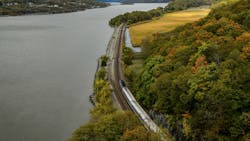MTA launches initiative to protect Hudson Line from climate change effects
The Metropolitan Transportation Authority (MTA) launched an initiative to protect the Hudson Line from the effects of climate change through investments that will fortify the line against future stormwater runoff, tidal floods and other risks. MTA notes the effort is known as the Metro-North Hudson Line Climate Resilience Blueprint and will rebuild critical infrastructure – including culverts, drainage, retaining walls, slopes, shorelines and track – with attention focused on a 20-mile stretch between Riverdale and Croton-Harmon, N.Y., that is vulnerable to the impacts of extreme weather.
MTA says the blueprint will also outline design guidance and actions to protect the entirety of the Hudson Line from the effects of climate change and ensure a coordinated approach is taken for all future Hudson Line projects, including target track elevations, standards for waterfront shoreline improvements and performance criteria for drainage.
“Securing the next generation of great public transit along the Hudson Line means investing in infrastructure to protect Metro-North from climate change,” said MTA Construction and Development (C&D) President Jamie Torres-Springer. “The Hudson Line Climate Resilience Blueprint will give us a clear path to make our service stronger and more reliable, and we’re excited to share our vision with the commuters who depend on it.”
Metro-North President Justin Vonashek added, “By the 2050s, 80 percent of the Hudson Line will be at increased risk of flooding due to rising sea levels and more frequent severe weather events. The Hudson Line is a key economic driver for the Hudson Valley, and it’s important that we make these crucial investments to protect the future of not only the railroad, but the entire coastal area.”
According to the MTA, a flagship project in the 2025-2029 Capital Plan that was a direct outgrowth of the findings in the MTA's Climate Resilience Roadmap, the blueprint builds on the MTA and C&D’s commitment to “better, faster, cheaper” to ensure projects are completed on time and on budget by maximizing opportunities to bundle construction projects that address a state of good repair.
MTA notes the capital plan is a historic $68.4 billion investment in the region’s subways, buses, railroads, bridges and tunnels during the next five years that ensures New Yorkers continue to have access to reliable, accessible and sustainable transit. The plan includes targeted investments to rebuild, improve and expand the transit system and will enable the MTA to continue to provide frequent and reliable service by putting the system on a path to a state of good repair, including investments in railcars, power and signals.
According to the authority, the plan will also improve the customer experience, with investments in accessibility, stations and modern fare gates and take action on climate change, including resiliency and sustainability initiatives. The plan builds on the most detailed system-wide evaluation the MTA has ever undertaken, the Twenty-Year Needs Assessment.
